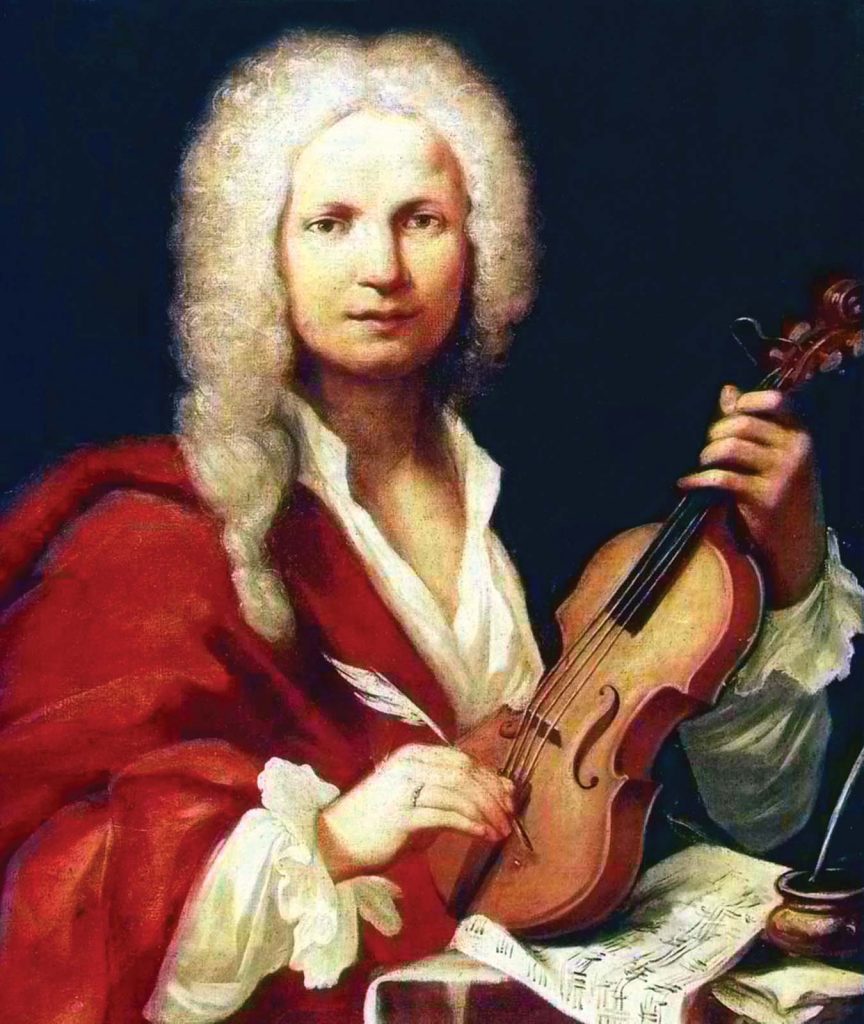by Jarrett Hoffman

•Today: No Exit presents Aether Eos (pictured) and CIM puts on Music for Food Benefit Concert
•Announcements: CIM’s new FUNdamentals summer camp
•Interesting reads: “How can the music industry respond to climate change and sustainability?”
•Almanac: the composer whose name is synonymous with all four seasons
HAPPENING TODAY:
Two free events this evening.
At 7, No Exit presents Aether Eos, the duo of violinist/composer/visual artist Leah Asher and pianist/composer Christopher Goddard. Their program at KSU’s Ludwig Recital Hall includes 21st-century works by Tonia Ko (plush earth in four pieces), Carrie Frey (Seagrass/Reed), Linda Caitlin Smith (Unbroken), and Michael Hersch (the wreckage of flowers) as well as a visit to the 1920s via Giacinto Scelsi (Chemin du Coeur).
Another pairing of old and new comes at 7:30 with a CIM Music for Food Benefit Concert at Mixon Hall. The program includes works written within the last five years — Reena Esmail’s Inconvenient Wounds and Shawn Okpebholo’s Rise — along with Giuseppe Verdi’s “Tower Scene Duet” from Il Trovatore and Robert Schumann’s Piano Quintet in E-flat, Op. 4. Reservations required.
ANNOUNCEMENTS:
Applications are open for CIM’s new FUNdamentals summer camp (July 29 – August 2). The program is aimed at children in grades 2-6, who will learn about instruments, sing in groups, listen to advanced players, and develop a sense of rhythm and musical literacy. More information here.
INTERESTING READS:
“How can the music industry respond to climate change and sustainability?” writes Anya Wassenberg for Ludwig Van. “Organized by the Music Sustainability Alliance, the first-ever Climate Summit in North America took place in Los Angeles this month. It saw roughly 300 attendees from across the music industry sectors participate in a day’s worth of panels and discussions on everything from carbon emissions to making environmentally responsible choices regarding food offerings.” Read the article here.
TODAY’S ALMANAC:
by Mike 2022

Vivaldi’s page on London’s Classic FM highlights many fun facts about the composer, who was nicknamed il Prete Rosso (“The Red Priest”). Here are a few to ponder.
- Vivaldi was baptized immediately after he was born, in his own home. This could have been due to his ill health, or the earthquake that shook Venice on the day of his birth.
- Vivaldi suffered from what he called ‘strettezza di petto’ (tightness of the chest) throughout his life — this severe asthma inhibited his speech, and even made him weak and dizzy when he spoke.
- Despite the fact Vivaldi wrote around 800 different works, his music was rarely played after his death in 1741, when his manuscripts were locked away or even attributed to other composers because he was deemed to be out of favor.
- Alongside his religious duties, the composer spent 37 years of his life as a composer, teacher, and conductor at the Pio Ospedale della Pietà asylum for orphaned girls.
- Vivaldi wrote fragments of poetry on the manuscript for his The Four Seasons, and no one’s sure who authored them.
- The Four Seasons may well be his most famous piece, but Vivaldi wrote more than 500 other concertos for other instruments including mandolin, cello, flute, viola d’amore, recorder, and lute. Around 230 of these are for violin — he was, after all, a violinist, like his father.
A fun fact that was not included is that Vivaldi wrote 39 Bassoon Concertos. Click here to listen to Klaus Thunemann perform the Concerto in g, RV 495 with I Musici.

The young Davidovsky began studying the violin at age seven and began composing at thirteen. After studying composition and theory at the University of Buenos Aires, in 1958 he went on to study with Aaron Copland and Milton Babbitt at what is now known as the Tanglewood Music Center. That experience was transformative for Davidovsky — because of Babbitt he became interested in electroacoustic music and it was Copland who encouraged him to move to the United States. In 1960 he relocated to New York.
Davidovsky’s best known compositions are his Synchronisms, which incorporate acoustic instruments and electroacoustic sounds. From 1981 until 1993 he taught at Columbia University as well as serving as director of the Columbia-Princeton Electronic Music Center. In 1994 he was appointed to the music faculty at Harvard.
His many recognitions include The American Academy of Arts and Letters’ Academy Award, a Pulitzer Prize, the Aaron Copland-Tanglewood Award, the Naumburg Award, and the Peggy Guggenheim Award. In 1982 he was elected a member of the American Academy of Arts and Letters.
In his New York Times obituary, composer and Davidovsky student Eric Chasalow remembered his mentor as being among the first “to make electronics nuanced the way a violin is,” adding, “He tried to make the electronic an extension of the organic.”
In the same article, guitarist and New Focus Recordings founder Dan Lippel said that “[Davidovsky] wrestled with this idea that he didn’t want to be someone who contributed to the dissolution of the human being onstage,” adding that “He was a real humanist.”
Click here to listen to violinist David Bowlin play Synchronisms No. 9.



